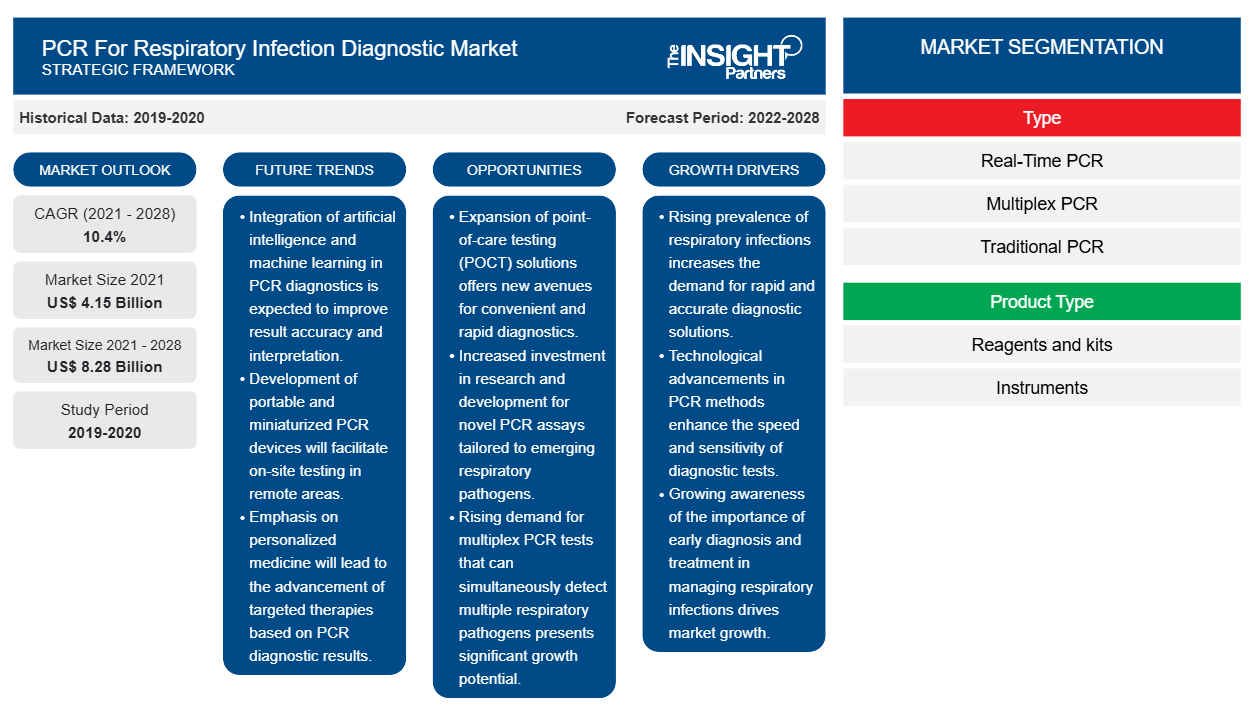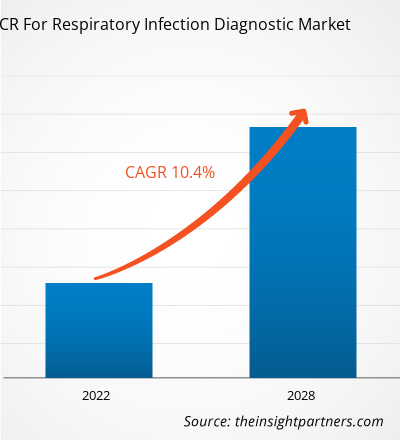The PCR for respiratory infection diagnostics market was valued at US$ 8279.32 million by 2028 from US$ 4146.02 million in 2021; it is estimated to grow at a CAGR of 10.4% from 2021 to 2028.
Polymerase chain reaction (PCR) is used for accurate point of care diagnostics that help rapidly identify and determine the cause of respiratory tract infections. In addition, PCR is widely preferred in inpatient and outpatient settings that help enhance the growth of the market in recent years.
The growth of the PCR for respiratory infection diagnostics market is attributed to the factors such as the increasing Burden of Chronic Respiratory Diseases (CRDs), growing developments in PCR testing, are widely enhancing the performance of medical devices. However, use of PCR testing for various respiratory infection diagnostics and developments in PCR technology being used to derive them. The availability of alternative assays hinders the market growth.
Customize This Report To Suit Your Requirement
You will get customization on any report - free of charge - including parts of this report, or country-level analysis, Excel Data pack, as well as avail great offers and discounts for start-ups & universities
PCR For Respiratory Infection Diagnostic Market: Strategic Insights

-
Get Top Key Market Trends of this report.This FREE sample will include data analysis, ranging from market trends to estimates and forecasts.
Market Insights
Market Consolidations Strategies Adopted by Use of PCR Testing for Various Respiratory Infection Diagnostics
PCR testing is the gold standard for detecting respiratory infectious diseases, including SARS-CoV-2. Also, the growing developments in PCR are not limited to the COVID-19 testing. The continuous technological developments have allowed researchers to develop advanced PCR techniques at a reduced cost and limit their complexities. It is expected that PCR testing will enhance its capabilities for molecular diagnostics and strengthen its role in the future with the ongoing developments of technologies such as microfluidics and next-generation sequencing. In addition, PCR testing is significantly used in institutions such as nursing homes, chronic care facilities, and hospitals, for identifying influenza virus infection that causes respiratory outbreaks.
Moreover, acute and chronic respiratory infections are among the leading causes of morbidities in the developed and developing countries globally. It is estimated that acute respiratory diseases account for nearly 75% of the total acute morbidities globally. Therefore, various companies are offering various PCR kits that can detect the presence of pathogens that cause respiratory diseases. For instance, companies such as bioMérieux SA and altona Diagnostics GmbH provide a wide range of PCR kits that can detect acute respiratory infection in the upper or lower respiratory tract. Apart from the increasing incidence of acute and chronic respiratory diseases, other factors such as environmental and climatic conditions, air pollution, and discoveries of novel bacteria, viruses, and pathogens are likely to serve as vital growth opportunities for PCR testing for respiratory infection diagnostics in the coming future.
Type -Based Insights
The PCR for respiratory infection diagnostics market, by type, is segmented into real time PCR (qPCR), multiplex PCR, traditional PCR, digital PCR, reverse-transcriptase (RT-PCR), and others. The real-time PCR (qPCR) segment held the largest share of the market in 2021 and is anticipated to register the highest CAGR in the market during the forecast period.
Product Type-based Insights
Based on product type, the PCR for respiratory infection diagnostics market is segmented into reagents and kits, instruments, and others. The reagents and kits segment held the largest share of the market in 2021 and is anticipated to register the highest CAGR of in the market during the forecast period.
Infection Type-based Insights
Based on infection type, the PCR for respiratory infection diagnostics market is segmented into bacterial infection, viral infection, and fungal and other pathogens. In 2021, viral infections segment held the largest share of the market and is estimated to register the highest CAGR in the market during the forecast period.
End Users-based Insights
Based on end user, the PCR for respiratory infection diagnostics market is segmented into hospitals, physician clinics, clinical laboratories, academic and research institutions, biotech and pharma companies, and others. In 2020, clinical laboratories segment held the largest share of the market and is estimated to register the highest CAGR of in the market during the forecast period.
Product launches and approvals are the commonly adopted strategies by companies to expand their global footprints and product portfolios. Moreover, the breast reconstruction market players focus on the collaboration strategy to enlarge their clientele, which, in turn, permits them to maintain their brand name globally.
PCR For Respiratory Infection Diagnostic Market Regional InsightsThe regional trends and factors influencing the PCR For Respiratory Infection Diagnostic Market throughout the forecast period have been thoroughly explained by the analysts at The Insight Partners. This section also discusses PCR For Respiratory Infection Diagnostic Market segments and geography across North America, Europe, Asia Pacific, Middle East and Africa, and South and Central America.
PCR For Respiratory Infection Diagnostic Market Report Scope
| Report Attribute | Details |
|---|---|
| Market size in 2021 | US$ 4.15 Billion |
| Market Size by 2028 | US$ 8.28 Billion |
| Global CAGR (2021 - 2028) | 10.4% |
| Historical Data | 2019-2020 |
| Forecast period | 2022-2028 |
| Segments Covered |
By Type
|
| Regions and Countries Covered |
North America
|
| Market leaders and key company profiles |
|
PCR For Respiratory Infection Diagnostic Market Players Density: Understanding Its Impact on Business Dynamics
The PCR For Respiratory Infection Diagnostic Market is growing rapidly, driven by increasing end-user demand due to factors such as evolving consumer preferences, technological advancements, and greater awareness of the product's benefits. As demand rises, businesses are expanding their offerings, innovating to meet consumer needs, and capitalizing on emerging trends, which further fuels market growth.

- Get the PCR For Respiratory Infection Diagnostic Market top key players overview
By Type
- Real-Time PCR (qPCR)
- Multiplex PCR
- Traditional PCR
- Digital PCR
- Reverse-Transcriptase (RT-PCR)
- Others
By Product Type
- Reagents and Kits
- Instruments
- Others
By Infection Type
- Bacterial Infections
- Bordetella
- Streptococcus Pneumoniae
- Staphylococcus Aureus
- Haemophilus Influenzae
- Moraxella Catarrhalis
- Mycoplasma Pneumoniae
- Chlamydophila Pneumoniae
- Legionella
- Others
- Viral Infections
- Rhinoviruses
- Influenza Virus
- Severe Acute Respiratory Syndrome (SARS) CoV-2 Virus
- Respiratory Syncytial Virus (RSV)
- Adenovirus
- Enterovirus
- Parainfluenza
- Human Metapneumovirus (hMPV)
- Others
- Fungal and Other Pathogens
By End User
- Hospitals
- Physician Clinics
- Clinical Laboratories
- Academic and Research Institutions
- Biotech and Pharma Companies
- Others
By Geography
- North America
- US
- Canada
- Mexico
- Europe
- France
- Germany
- UK
- Spain
- Netherlands
- Norway
- Italy
- Rest of Europe
- Asia Pacific (APAC)
- China
- India
- Japan
- Australia
- South Korea
- Rest of Asia Pacific
- Middle East and Africa (MEA)
- Saudi Arabia
- UAE
- South Africa
- Rest of Middle East and Africa
- South and Central America (SCAM)
- Brazil
- Argentina
- Rest of South and Central America
Company Profiles
- Abbott
- F. Hoffmann-La Roche AG
- Hologic, Inc.
- Seegene Inc.
- AusDiagnostics
- BD
- Bio-Rad Laboratories Inc
- BioMérieux
- Qiagen
- Thermo Fisher Scientific Inc
Frequently Asked Questions
What is the regional analysis in terms of PCR for respiratory infection diagnostics?
What is PCR test mean?
What are the driving factors for the PCR for respiratory infection diagnostics market across the globe?
- Historical Analysis (2 Years), Base Year, Forecast (7 Years) with CAGR
- PEST and SWOT Analysis
- Market Size Value / Volume - Global, Regional, Country
- Industry and Competitive Landscape
- Excel Dataset
Recent Reports
Testimonials
Reason to Buy
- Informed Decision-Making
- Understanding Market Dynamics
- Competitive Analysis
- Identifying Emerging Markets
- Customer Insights
- Market Forecasts
- Risk Mitigation
- Boosting Operational Efficiency
- Strategic Planning
- Investment Justification
- Tracking Industry Innovations
- Aligning with Regulatory Trends





















 Get Free Sample For
Get Free Sample For